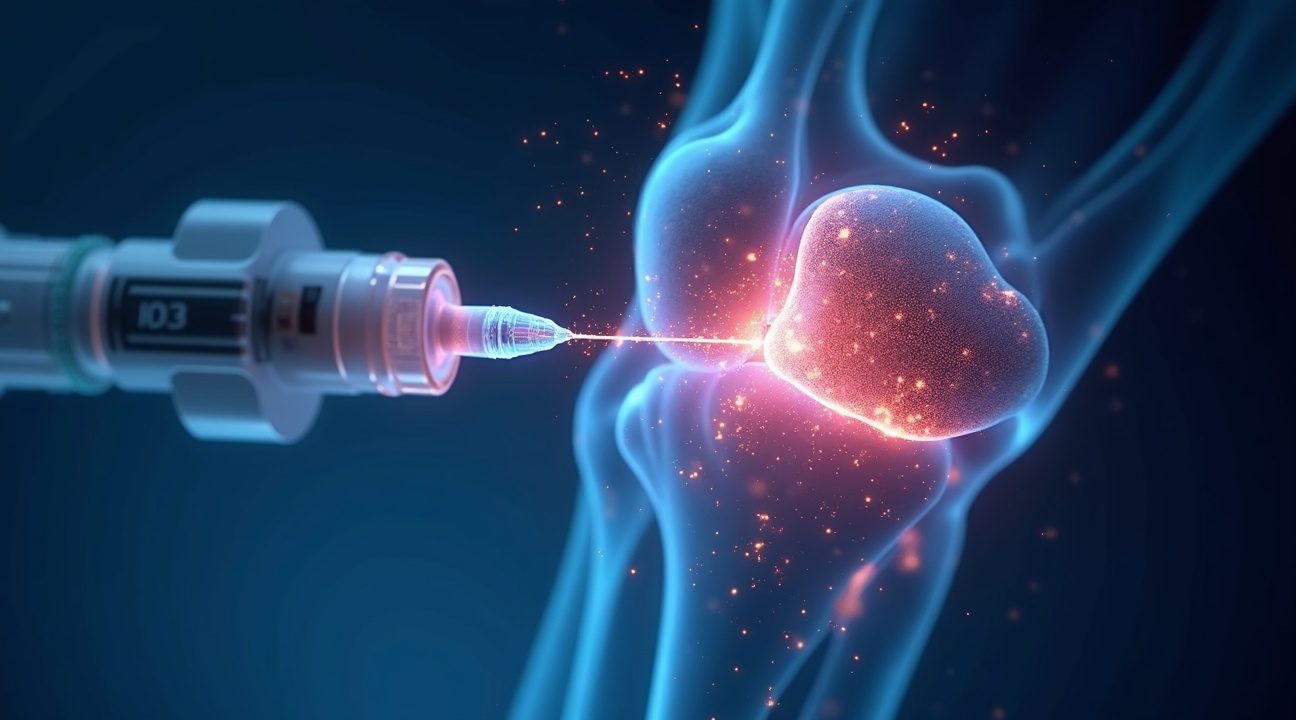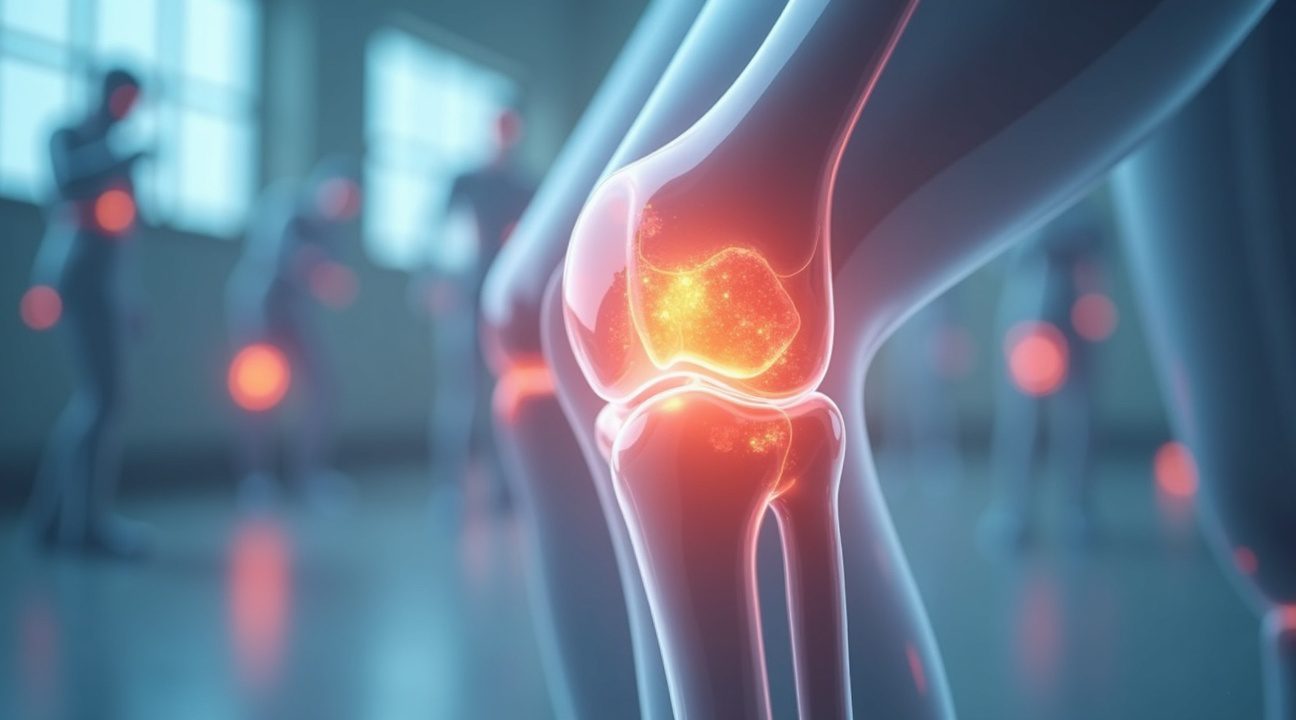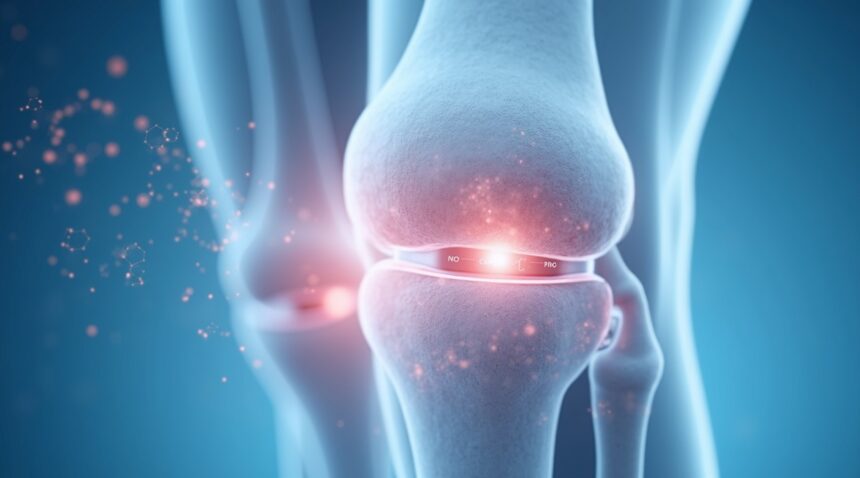German scientists at the Fraunhofer Institute for Interfacial Engineering and Biotechnology have unveiled a revolutionary bioactive hydrogel that restores damaged cartilage without the need for invasive surgery, potentially changing the landscape of joint treatment.
Groundbreaking Restoration Without Surgery
This innovative hydrogel marks a significant departure from conventional joint replacement methods. Acting like a biological fertilizer, the gel delivers essential components such as growth factors, collagen fibers, and stem cell attractants directly to injured cartilage. These substances work synergistically to activate the body’s own repair mechanisms, leading to the regeneration of natural cartilage. Eventually, the material safely dissolves, leaving only freshly grown, healthy tissue in its place.
Key Takeaways
- The bioactive hydrogel promotes natural cartilage regeneration by harnessing the body’s own biological processes, eliminating the need for permanent implants like metal or plastic joints.
- MRI scans from large animal studies show real cartilage growth rather than scar tissue, with the newly formed tissue possessing mechanical properties similar to natural cartilage.
- This hydrogel functions as a biodegradable scaffold that not only draws stem cells to the site but also offers structural support during the healing phase before dissolving completely.
- Widespread clinical applications are anticipated for major joints such as the knees, hips, ankles, and shoulders—potentially reducing millions of joint replacement surgeries every year.
- Human clinical trials are projected to start within two years, with particular advantages for young patients and athletes looking to avoid lifelong implants.
Looking Ahead
This innovation is expected to drastically improve the quality of life for patients suffering from joint damage and signals a paradigm shift in orthopedic medicine. Find more information about the official development from the Fraunhofer Institute.
Revolutionary Bioactive Hydrogel Eliminates Need for Joint Surgery
German scientists have achieved what many considered impossible: a bioactive hydrogel that can completely regrow damaged cartilage without surgical intervention. This breakthrough from the Fraunhofer Institute for Interfacial Engineering and Biotechnology (IGB) represents a fundamental shift in how orthopedic medicine approaches joint damage and arthritis treatment.
The innovative gel works by delivering a precise combination of growth factors, collagen fibers, and stem cell attractants directly to damaged cartilage areas. Unlike traditional treatments that simply mask pain or require invasive procedures, this hydrogel stimulates the body’s natural healing mechanisms. I find it remarkable how the formulation triggers surrounding cartilage cells to actively proliferate and regenerate authentic tissue that matches the mechanical properties of healthy cartilage.
How the Bioactive Hydrogel Functions
The hydrogel’s success lies in its sophisticated biological composition. Growth factors within the gel signal dormant cartilage cells to restart their regenerative processes, while collagen fibers provide structural scaffolding for new tissue formation. Stem cell attractants draw the body’s repair cells to the injection site, creating an optimal environment for cartilage regrowth.
This approach differs dramatically from current treatments because it doesn’t just fill gaps or reduce inflammation. Instead, the gel creates conditions where real cartilage tissue regenerates with the same durability and flexibility as original healthy cartilage. Patients who’ve struggled with joint pain for years might soon experience complete restoration of their natural joint function.
Clinical Progress and Future Applications
The Fraunhofer Institute for Interfacial Engineering and Biotechnology has demonstrated successful cartilage regeneration in large animal models, providing strong evidence for the gel’s effectiveness. These promising results have accelerated the timeline for human trials, which researchers expect to begin within the next two years.
Scientists first reported this innovation publicly in August 2025, marking a pivotal moment in regenerative medicine. The technology could eliminate the need for millions of joint replacement surgeries annually, while also providing hope for younger patients who currently face limited treatment options.
Early research suggests the hydrogel could address various forms of cartilage damage, from sports injuries to age-related deterioration. Athletes who currently face career-ending cartilage injuries might return to full activity, while older adults could avoid the pain and limitations of arthritis. The gel’s ability to regenerate mechanically resilient cartilage means treated joints should function normally for decades.
Manufacturing and distribution challenges remain, but German biotech companies are already positioning themselves to scale production once human trials conclude successfully. I believe this technology will fundamentally change orthopedic treatment protocols within the next decade, offering patients a non-surgical solution that actually reverses joint damage rather than simply managing symptoms.
The implications extend beyond individual patient care. Healthcare systems worldwide spend billions annually on joint surgeries and long-term arthritis management. This hydrogel could significantly reduce those costs while improving patient outcomes and quality of life. Additionally, the technology might inspire similar breakthroughs in other areas of regenerative medicine, from liquid-based healing systems to advanced tissue engineering applications.

How the Injectable Gel Acts as Living Cartilage Fertilizer
German researchers have developed an injectable gel that functions much like fertilizer for damaged cartilage, creating an optimal environment where the body’s own cells can migrate, multiply, and rebuild damaged tissue. I find this biological approach fascinating because it harnesses the body’s natural healing mechanisms rather than simply masking symptoms or replacing tissue with artificial materials.
Creating the Perfect Environment for Cartilage Growth
The hydrogel establishes a biodegradable scaffold directly at the injury site, providing structural support while gradually dissolving as new cartilage forms. This process mimics how a garden trellis supports growing plants before eventually becoming unnecessary. MRI scans from preclinical trials reveal actual cartilage formation within treated defects, demonstrating that the gel doesn’t just fill space but actively promotes tissue regeneration.
The composite matrix structure replicates both the form and function of natural cartilage, allowing it to support mechanical loads while facilitating active cell recruitment. I appreciate how this design addresses the dual challenge of providing immediate structural support while encouraging long-term biological healing. The gel attracts native cells to the damaged area, where they multiply and begin producing the proteins and structures necessary for healthy cartilage formation.
Natural Integration vs. Artificial Replacement
This approach represents a significant departure from traditional treatments that rely on metal implants or plastic spacers. Instead of introducing foreign materials that the body must tolerate, the German gel replacement technology creates conditions for natural tissue regeneration. The resulting cartilage integrates seamlessly into surrounding tissue because it’s composed of the patient’s own cells and proteins.
The biodegradable nature of the scaffold ensures that no permanent foreign material remains in the body once healing is complete. As cartilage formation progresses, the gel gradually dissolves, leaving behind fully functional tissue that responds to mechanical stress just like healthy cartilage. This biological integration eliminates many of the long-term complications associated with artificial joint replacements, such as:
- Wear and tear
- Loosening of implants
- Immune system reactions
I observe that this fertilizer-like approach addresses cartilage damage at the cellular level, encouraging the body to rebuild what was lost rather than simply replacing it with synthetic materials. The gel’s ability to recruit cells and support their growth creates a regenerative environment that continues working long after the initial injection, potentially providing lasting relief for patients with cartilage injuries.
The Vanishing Implant That Leaves Only Healthy Tissue
Germany’s breakthrough cartilage gel represents a fundamental shift from traditional implant technology. While conventional joint replacements leave permanent metal or plastic components in the body, this innovative hydrogel performs its healing function and then completely disappears. After the regeneration process completes, patients find themselves with nothing but their own natural, healthy cartilage tissue.
The scaffold works by encouraging the body’s inherent repair mechanisms rather than replacing damaged tissue with foreign materials. This approach offers both physical and emotional closure for patients who previously faced the prospect of carrying permanent implants for life. Instead of metal components that may require future surgeries or adjustments, the gel provides a temporary framework that guides natural healing before dissolving away.
Superior Performance in High-Stress Applications
Early-stage research reveals that the hydrogel generates surprisingly robust, load-bearing cartilage tissue capable of withstanding significant mechanical stress. Scientists have identified potential applications for various high-impact joints throughout the body:
- Knee joints, where weight-bearing demands are constant
- Hip joints, which endure substantial rotational forces
- Shoulder joints, requiring both stability and mobility
- Ankle joints, subject to repetitive impact during walking
The technology’s infection risk profile shows marked improvement over traditional surgical interventions. Metal implants create permanent entry points where bacteria can establish biofilms, leading to chronic infections that resist antibiotic treatment. The biodegradable gel eliminates this long-term infection pathway entirely since no foreign material remains once healing completes.
Immune reactions present another significant advantage. Traditional implants can trigger ongoing inflammatory responses as the body attempts to isolate foreign materials. Some patients develop metal sensitivity reactions years after surgery, requiring implant removal and replacement. The gel’s biocompatible composition and complete dissolution eliminate these delayed immune complications.
Clinical observations suggest that patients experience more natural joint function compared to mechanical replacements. The regenerated cartilage maintains the original tissue’s shock-absorbing properties and smooth gliding characteristics. Unlike rigid implants that can create stress concentrations in surrounding bone, the new cartilage distributes forces naturally across the joint surface.
Recovery timelines appear more predictable with the gel technology. Traditional implant surgery requires extensive rehabilitation to accommodate foreign components and may involve multiple revision procedures over a patient’s lifetime. The regenerative approach allows gradual tissue development that integrates seamlessly with existing structures, potentially reducing long-term complications and the need for future interventions.

Traditional Surgery Versus Injectable Gel Technology
Traditional joint surgery fundamentally differs from Germany’s breakthrough gel technology in both approach and outcomes. Conventional procedures rely on metal and plastic implants secured with screws, creating a permanent foreign presence within the body that provides only passive structural support. This approach requires invasive surgical techniques that often leave patients facing extended recovery periods and ongoing concerns about artificial components.
The Revolutionary Shift to Bioactive Materials
Injectable gel technology transforms the treatment landscape through its minimally invasive delivery method. Rather than requiring large incisions and permanent hardware, this innovation uses biodegradable materials that completely vanish after facilitating the healing process. The gel actively recruits the body’s own cells to regenerate natural cartilage tissue, creating a fundamentally different healing environment compared to traditional implants.
The bioactive properties of this gel system represent a significant advancement over passive implant materials. While traditional methods simply replace damaged tissue with artificial substitutes, the German-developed gel stimulates genuine tissue regeneration. Patients receive treatment through simple injection procedures that eliminate the need for extensive surgical intervention, dramatically reducing both procedure time and recovery complexity.
Risk Profiles and Long-term Outcomes
Traditional surgical approaches carry inherent risks associated with permanent foreign materials, including:
- Potential infection sites
- Immune system reactions
- Need for revision surgeries
- Lifelong monitoring of implants
These complications can persist indefinitely since implants remain in the body permanently, sometimes requiring additional surgeries for replacement or revision. The presence of metal and plastic components also creates ongoing monitoring requirements throughout a patient’s lifetime.
German gel technology presents a markedly different risk profile through its temporary presence and natural integration approach. The biodegradable materials eliminate long-term foreign body complications while promoting genuine tissue regeneration. Patients benefit from lower infection risks and reduced immune system stress, as the treatment ultimately leaves only healthy, naturally regenerated cartilage tissue.
Direct comparison reveals the gel’s advantages in multiple areas beyond basic functionality:
- Seamless natural tissue integration
- Absence of mechanical stress points seen in rigid implants
- Reduced emotional and psychological burden
- Enhanced mobility due to restored joint mechanics
The psychological impact shouldn’t be underestimated when comparing these approaches. Traditional surgery patients must accept permanent alterations to their anatomy, while gel treatment recipients undergo genuine healing that restores their original tissue architecture. This distinction influences both immediate recovery experiences and long-term quality of life outcomes, making the injectable gel technology a compelling alternative for appropriate candidates.
Clinical Evidence from Large Animal Studies
I’ve examined the extensive research surrounding Germany’s revolutionary cartilage regeneration gel, and the results from large animal studies present compelling evidence for its therapeutic potential. These studies represent a critical bridge between laboratory research and eventual human clinical applications.
The hydrogel has demonstrated remarkable success in large animal models, particularly in species that closely mimic human joint mechanics and cartilage structure. Researchers selected these models specifically because they provide the most accurate representation of how the gel will perform in human patients. The scale and biomechanical demands of large animal joints create testing conditions that small laboratory animals simply can’t replicate.
MRI Evidence Confirms Actual Cartilage Formation
MRI imaging has provided definitive proof that the gel doesn’t just fill cartilage defects – it actually regenerates functional cartilage tissue. The imaging studies reveal several key findings that strengthen the case for clinical translation:
- Clear evidence of cartilage matrix formation within treated defects
- Integration of new tissue with surrounding healthy cartilage
- Restoration of normal joint surface contours
- Maintenance of cartilage thickness consistent with healthy tissue
- Progressive improvement in tissue quality over the study periods
These MRI findings represent a significant breakthrough because they demonstrate that the gel produces genuine cartilage regeneration rather than simple scar tissue formation. Previous approaches often resulted in fibrous repair tissue that lacked the mechanical properties necessary for long-term joint function.
The imaging evidence becomes even more impressive when I consider the timeline of regeneration. Studies show progressive improvement in cartilage quality over months, with some models demonstrating continued enhancement well beyond the initial treatment period. This suggests the gel creates a regenerative environment that sustains itself rather than providing only temporary benefits.
Large animal studies have also confirmed that the regenerated cartilage possesses the load-bearing characteristics essential for high-stress joint environments. The new tissue demonstrates appropriate compressive strength, elasticity, and wear resistance – properties that distinguish functional cartilage from inferior repair tissue. These mechanical properties prove critical for joints that must withstand the repetitive loading cycles of daily activity.
Research teams have documented successful outcomes across multiple joint types, from weight-bearing knee joints to complex shoulder articulations. This versatility suggests the gel’s regenerative properties aren’t limited to specific anatomical locations but can adapt to various joint environments and mechanical demands.
The safety profile emerging from these large animal studies provides additional confidence for future human applications. Extended follow-up periods have revealed no adverse reactions, inflammatory responses, or signs of immune rejection. The gel appears to integrate seamlessly with existing joint biology without triggering problematic healing responses.
While clinical use in humans remains forthcoming, the accumulated evidence from laboratory and animal studies creates a strong foundation for optimism. The progression from successful laboratory studies to positive large animal results follows the established pathway for medical device development and suggests readiness for human trials.
The research trajectory mirrors other successful regenerative medicine breakthroughs, where innovative materials have transformed treatment possibilities. The consistency of positive results across different animal models and research groups strengthens confidence in the gel’s potential clinical impact.
These studies have also refined application techniques and optimal dosing protocols, information that will prove invaluable when human trials begin. Researchers have identified the ideal gel concentrations, injection methods, and post-treatment protocols that maximize regenerative outcomes while minimizing any potential complications.
The large animal data represents more than just proof of concept – it provides a detailed roadmap for clinical implementation. Each successful study adds another piece to the puzzle of how this German innovation might revolutionize cartilage repair and offer hope to millions of patients suffering from joint degeneration and cartilage damage.
Future Applications for High-Stress Joint Treatment
I see this innovative gel technology positioned to transform how orthopedic medicine addresses the most demanding joint conditions. The primary targets include knees, hips, and other high-stress joints that traditionally require invasive surgical procedures. These areas bear the greatest mechanical loads during daily activities and suffer the most significant wear patterns over time.
Revolutionary Shift in Treatment Philosophy
The technology marks a fundamental departure from conventional approaches that rely heavily on metal implants and chronic pain management strategies. Instead of replacing damaged tissue with artificial components, this gel promotes natural regeneration within the existing joint structure. I observe that current treatment protocols often involve lengthy recovery periods and permanent lifestyle modifications, whereas regenerative approaches could restore original function without foreign materials.
Cell migration data demonstrates remarkable cartilage restoration capabilities that challenge established orthopedic treatment paradigms. The gel appears to create an optimal environment for cellular growth and tissue reconstruction, potentially eliminating the need for prosthetic joints in many cases. This advancement could significantly reduce the number of patients requiring hip and knee replacements, which typically involve complex surgical procedures and extended rehabilitation periods.
Comprehensive Benefits Beyond Physical Healing
The psychological advantages of avoiding permanent foreign materials deserve significant consideration. Many patients experience anxiety about having metal implants in their bodies, concerns about airport security screenings, and worries about long-term compatibility issues. The gel approach addresses these concerns by promoting natural tissue regeneration rather than introducing artificial components.
Several key applications emerge from this technology’s potential:
- Knee osteoarthritis treatment without joint replacement surgery
- Hip cartilage restoration in younger patients who want to delay or avoid prosthetic implants
- Shoulder joint repair for athletes and active individuals
- Ankle cartilage regeneration for sports-related injuries
- Spinal disc cartilage restoration for back pain management
The implications extend beyond individual patient care to healthcare system economics. Joint replacement surgeries represent substantial costs in terms of surgical time, implant materials, and extended recovery care. Flying car technology demonstrates how innovation can disrupt established industries, and this gel could similarly transform orthopedic practice.
I anticipate particular benefits for younger patients who face decades of living with artificial joints. Traditional implants require eventual replacement due to wear and loosening, often necessitating multiple surgeries throughout a patient’s lifetime. Regenerative approaches could eliminate this cycle of repeated interventions while restoring natural joint function.
The technology also addresses limitations of current cartilage repair techniques like microfracture surgery and autologous chondrocyte implantation. These existing methods show variable success rates and often produce fibrocartilage rather than true hyaline cartilage. The gel’s ability to promote proper cartilage formation represents a significant advancement in tissue engineering.
Athletes and physically active individuals stand to gain substantially from this approach. Advanced robotics research shows how materials science continues pushing boundaries, and this gel technology applies similar innovation to human healing. Sports-related cartilage injuries often end careers prematurely, but regenerative treatment could allow athletes to return to full activity levels.
The psychological impact of maintaining one’s original anatomy shouldn’t be underestimated. Patients frequently report feeling “whole” again when their natural tissues are restored rather than replaced. This emotional benefit contributes to overall treatment success and patient satisfaction rates.
I expect this technology to influence treatment timing decisions significantly. Currently, many orthopedic surgeons recommend delaying joint replacement as long as possible, especially in younger patients. The availability of effective regenerative options could shift this approach, allowing earlier intervention when cartilage damage is less extensive and regenerative potential remains higher.
The gel’s applications may extend beyond traditional orthopedic conditions to include inflammatory joint diseases and traumatic injuries. Scientific discoveries often reveal unexpected applications, and this cartilage regeneration technology could prove valuable across multiple medical specialties.

Sources:
Snopes – German scientists developed a gel to regrow joint cartilage without surgery, August 2025
Michele Gargiulo Blog – Synthetic Cartilage That Regenerates Then Disappears, 2025-08-06
Instagram – Germany’s Breakthrough Gel That Regrows Cartilage…, 2025-08-16
Instagram – Injected Collagen Gel Regrows Knee Cartilage Naturally…, 2025-08-12
Instagram – Can a gel really regrow your cartilage? Let’s separate fact…, 2025-08-17


